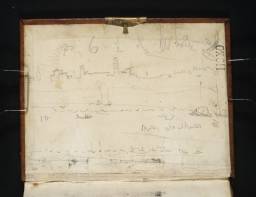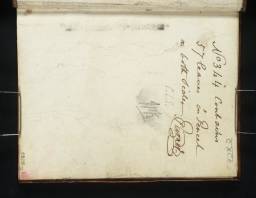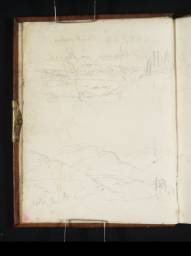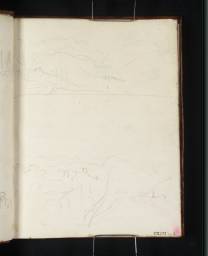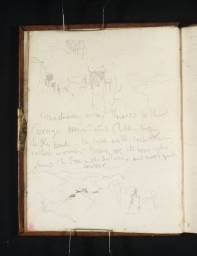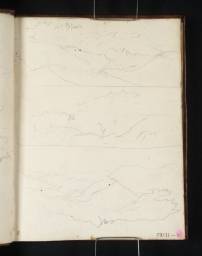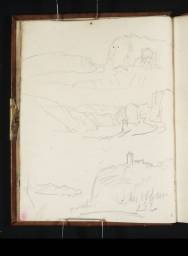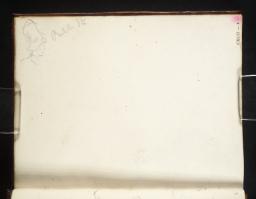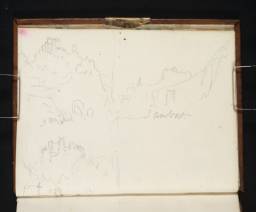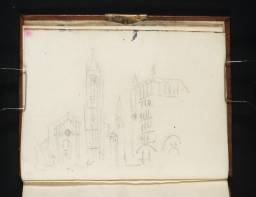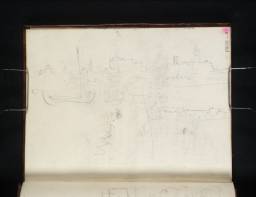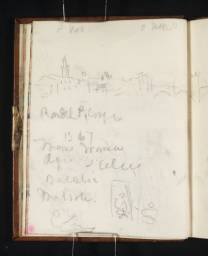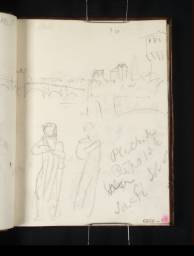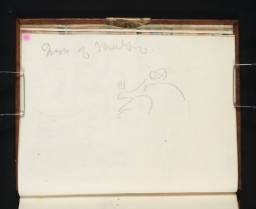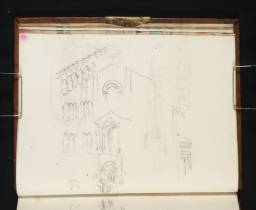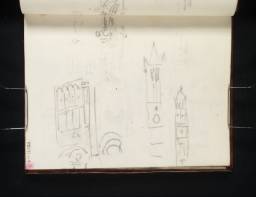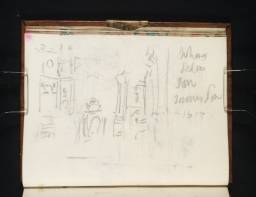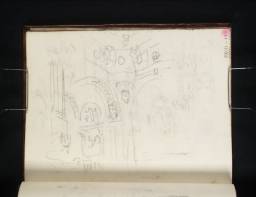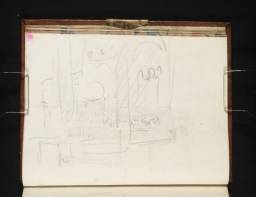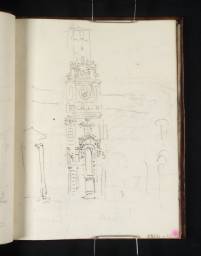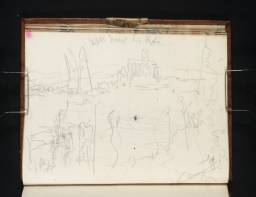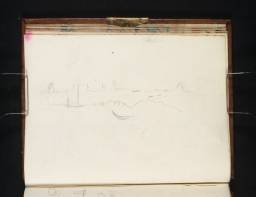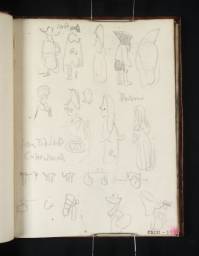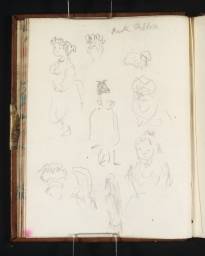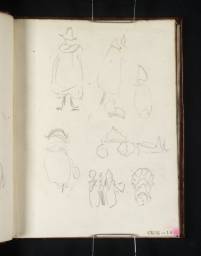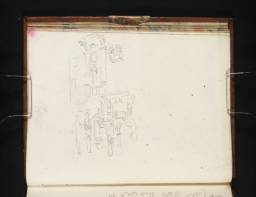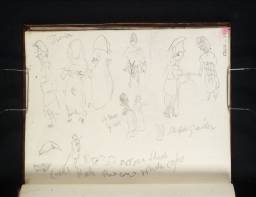Turner Bequest CXCII
Brown leatherbound pocket book, cover tooled in black lines, one brass clasp (missing)
67 leaves of two types of white wove writing paper, approximate page size 128 x 98 mm
Made by William Balston of Springfield Mill, Maidstone, Kent; various pages watermarked ‘J WHATMAN | 1814’ and ‘J WHATMAN | 1818’
67 leaves of two types of white wove writing paper, approximate page size 128 x 98 mm
Made by William Balston of Springfield Mill, Maidstone, Kent; various pages watermarked ‘J WHATMAN | 1814’ and ‘J WHATMAN | 1818’
Inscribed by the artist in black ink on the back cover ‘Return from Italy’ centre right, descending right-hand edge (D40987)
Inscribed by an unknown hand in pencil on the front cover ‘S67’ centre
Stamped in black on the front cover ‘CXCII’ top right
Inscribed by an unknown hand in pencil on the front cover ‘S67’ centre
Stamped in black on the front cover ‘CXCII’ top right
Accepted by the nation as part of the Turner Bequest 1856
References
This sketchbook is one of twenty-three used by Turner during his first tour of Italy in 1819–20. Following the artist’s own label the book is called ‘Return from Italy’, and the contents comprise views relating to the homeward journey through northern Italy and France in January 1820. Some overlap in subject matter occurs with the Remarks (Italy) sketchbook (Tate; Turner Bequest CXCIII) and also with the Paris, France, Savoy 2 sketchbook (Tate; Turner Bequest CLXXIII) which documents the outward leg of the same itinerary.
Turner’s return journey took place during January 1820 (hence the dating of the sketchbook and its contents). He left Florence early in the month (see the Rome and Florence sketchbook, Tate; Turner Bequest CXCI) and headed north to Bologna where he joined the Via Emilia and followed it north-west to Milan. Sketches relating to this part of the journey include views of Parma (see folio 5 verso, D16650) and Piacenza (see folio 61 verso, D16749; Turner Bequest CXCII 60a), while several Milanese studies testify to the fact that he must have stayed in the city for at least a day (see below). From Milan, Turner retraced his steps from the outward route through Piedmont and Savoy, returning via Turin and Susa to the Mont Cenis pass. The passage through the Alps represented the most dangerous part of the entire tour. The journey coincided with an unusually severe period of cold weather in northern Italy and Turner and his fellow travellers encountered difficulties with heavy snow in the mountains.1 He later described the events in a letter to a friend, James Holworthy:
We were capsized on the top [of Mont Cenis]. Very lucky it was so; and the carriage so completely frozen that we were obliged to get out at the window – the guide and Cantonier began to fight, and the driver was by a process verbal put into prison, so doing while we had to march or rather flounder up to our knees nothing less in snow all the way down to Lancesbyburgh [sic, i.e. Lanslebourg] by the King of Roadmakers Road, not the Colossus of Roads, Mr MacAdam, but Bonaparte, filled up by snow and only known by the precipitous zig-zag.2
This dramatic experience of being overturned in the Alps provided the inspiration for a later watercolour Snowstorm, Mont Cenis, 1820 (Birmingham Museums and Art Gallery). According to an inscription within this picture the incident took place on 15 January,3 while a further inscription on folio 17 (D16673) indicates that Turner was somewhere within the French side of the Alps, possibly near Lanslebourg, on 24 January. The rest of the homeward journey through Savoy and France followed the same itinerary as that documented within the Paris, France, Savoy 2 sketchbook, albeit in reverse. Turner chose to make far fewer sketches on this occasion and avoided repetition of subjects he had already depicted, although there are views of Lyon (see folio 37 verso, D16712; Turner Bequest CXCII 36a) and Auxerre (folio 45, D16727; Turner Bequest CXCII 44). He also recorded part of the route within the Remarks (Italy) sketchbook, including the final stretch from Calais to Dover (see Tate D16886; Turner Bequest CXCIII 104), finally arriving back in London on 1 February 1820.4
Unlike most of the other sketchbooks from the first Italian tour, the subjects represented within these pages do not follow the logical geographical progression of the artist’s route. Studies of buildings in Milan, for example, can be found interspersed throughout the sketchbook and variously include: the Palazzo dei Giureconsulti (folio 11, D16661); the Casa degli Omenoni (folio 14 verso, D16668); the interior of the Duomo (folios 28 verso–29 verso, D16694–D16696; Turner Bequest CXCII 27a–28a); the Palazzo delle Scuola Palatine (folio 45 verso, D16728; Turner Bequest CXCII 44a); the Palazzo Marino (folio 46 verso, D16730; Turner Bequest CXCII 45a); and Santa Maria delle Grazie (folio 47, D16731; Turner Bequest CXCII 46). Another unusual characteristic is the greater proportion of figure studies that the sketchbook contains and also the large quantity of written inscriptions, mainly representing descriptions of atmospheric effects within the mountains. Conversely, the quality of draughtsmanship in the landscape sketches is generally rougher and hastier than that which characterises the careful topographical studies Turner made during the rest of the trip. During his survey of the Turner Bequest during the mid-nineteenth century John Ruskin informally described the contents as ‘Rubbish’,5 although he later regretted the repetition of his comments which he never intended to be permanent.6 The schematic nature of the drawings and the illegibility of many of the artist’s written inscriptions, probably reflects the challenging winter weather conditions through which Turner was travelling, and is also perhaps indicative of a sense of ‘winding down’ at the end of this long, intense six-month trip. The rudimentary appearance of some of the sketches, coupled with the disordered and scattered arrangement of the subject matter, makes identification of some of the views difficult to achieve.
Technical notes
How to cite
Nicola Moorby, ‘Return from Italy sketchbook 1820’, sketchbook, April 2013, in David Blayney Brown (ed.), J.M.W. Turner: Sketchbooks, Drawings and Watercolours, Tate Research Publication, August 2013, https://www

